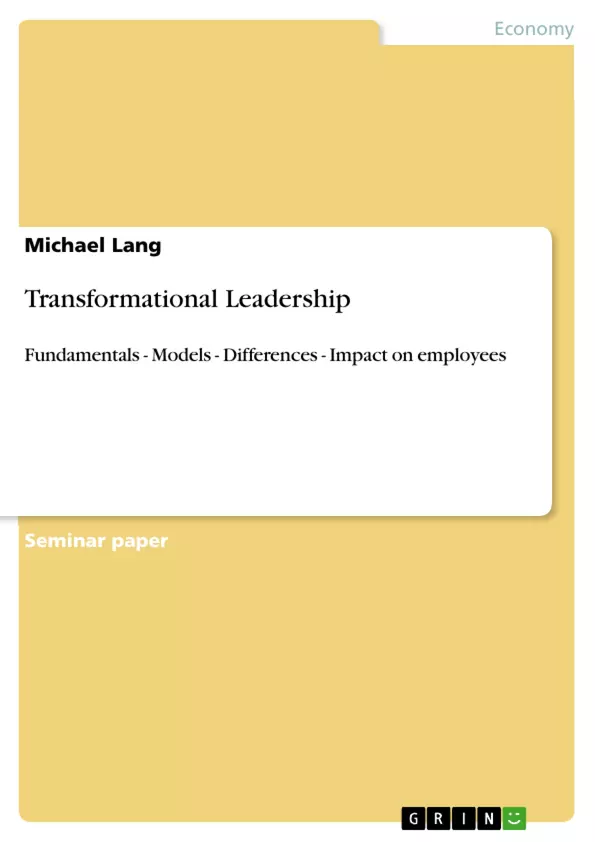"Transformational leadership is the buzzword in business today.
It conveys passionate commitment. It inspires hope because it promises a purposeful way forward to a positive mind-changing and life-changing future."
(Lim, 2010)
The author Lim (2010) emphasises in his article the popularity of transformational leadership in the world of the 21th century. According to Lim (2010) the economic and social environment is changing constantly with an increasing speed. Therefore many politics and business executives ask themselves how they should cope with the changed circumstances, such as globalisation and global poverty (Bass & Riggio, 2005, p. 224). From Burns’s (2003) point of view transformational leadership gives answers to these most critical questions of the world. The transformational leadership model helps leaders to prepare themselves and their followers for the future. It is a process that changes and transforms people. It deals with emotions, values, ethics standards and long-term goals.
Finally, it pushes the follower to the unexpected and creates a common vision (Northouse, 2009, p. 186).
However, there arises the question what is transformational leadership really and why is it so popular in contrast to other types of leadership? In order to answer these questions chapter 2 defines the terms leadership, management and outlines the contrast between leaders and managers. Chapter 3 presents the main
chapter of this assignment. It gives a brief overview of different leadership models and their characteristics in section 3.1. The following three sections deal with the transactional and transformational leadership model and their impact on behaviour and performance of employees. Moreover chapter 4 discusses the dvantages and disadvantages of transformational leadership theories. Finally chapter 5 summarizes the basic insights and gives a
short perspective.
Inhaltsverzeichnis (Table of Contents)
- Introduction
- Fundamentals
- Fundamentals of Leadership
- Trait Leadership Theory
- Process Leadership Theory
- Fundamentals of Management
- Management versus Leadership
- Fundamentals of Leadership
- Leadership Models
- Overview of Leadership Models
- Transactional Leadership
- Definition of Transactional Leadership
- Components of Transactional Leadership
- Transformational Leadership
- Definition of Transactional Leadership
- Components of Transformational Leadership
- Other Transformational Leadership Theories
- Measurement and Application of Transformational Leadership
- Transactional versus Transformational Leadership
- Discussion
- Strengths of Transformational Leadership
- Criticisms on Transformational Leadership
- Summary and Prospects
Zielsetzung und Themenschwerpunkte (Objectives and Key Themes)
This assignment aims to provide a comprehensive understanding of transformational leadership. It examines the fundamentals of leadership and management, highlighting the key differences between these two concepts. The paper then delves into various leadership models, focusing on the transactional and transformational leadership models and their impact on employees. Finally, it explores the strengths and weaknesses of transformational leadership theories.
- Fundamentals of Leadership and Management
- Transactional and Transformational Leadership Models
- Impact of Leadership on Employee Behaviour and Performance
- Strengths and Criticisms of Transformational Leadership
- Application and Measurement of Transformational Leadership
Zusammenfassung der Kapitel (Chapter Summaries)
Chapter 1 introduces the concept of transformational leadership and its significance in the contemporary business environment. It highlights the changing economic and social landscape and the need for leaders to adapt to these changes.
Chapter 2 delves into the fundamentals of leadership, outlining both the trait and process perspectives. It explores the key characteristics associated with effective leadership, such as intelligence, self-confidence, determination, integrity, and sociability.
Chapter 3 presents an overview of different leadership models, focusing on the transactional and transformational leadership models. It defines these models, outlines their key components, and examines their impact on employee behavior and performance.
Schlüsselwörter (Keywords)
Transformational leadership, transactional leadership, leadership models, management, employee behavior, performance, strengths, criticisms, application, measurement.
- Arbeit zitieren
- Dipl.-Ing. (DH) Michael Lang (Autor:in), 2010, Transformational Leadership, München, GRIN Verlag, https://www.grin.com/document/164198



